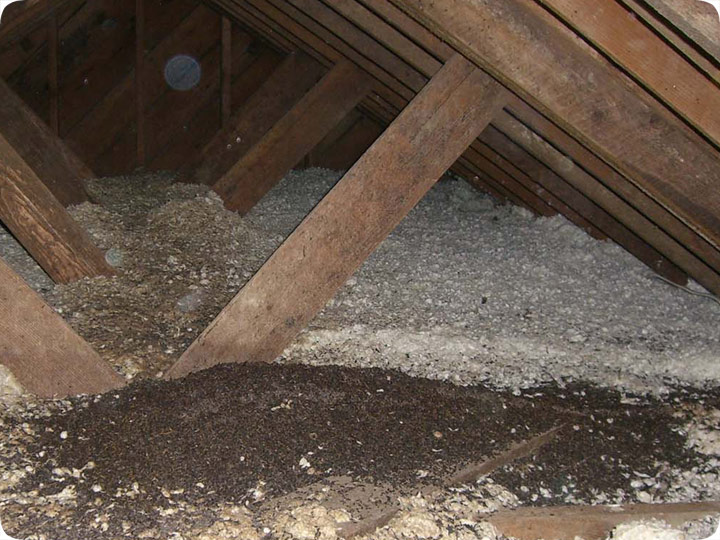-
info@aaanimalcontrol.com
Call us for help in your town
Humane Wildlife Education
Bat Poop - Droppings & Waste in an Attic

08.15.2007 - The biggest problem with a colony of bats living in the attic is that they poop a lot. If the group of bats is very large, the waste can really build up.
Some colonies of bats are over 1000 members in number. Each bat makes about 6-8 bat turds per day. They live in the attic year-round. That means a lot of bat
crap. In the above photo, a small group of 40 bats were living in an attic. They roosted across the length of the attic ridge, but most of the bats roosted in one
area. Below that lay a pile of bat droppings, or guano, as seen in the above photo. This is a relatively mild case. I once worked in an attic where every
square inch of the attic was filled with droppings at least a foot deep! That attic had 3000 bats, that had lived there for a long time. The ceiling was cracking
under the weight of all that guano.
The problems with bat droppings, or any animal droppings, for that matter in an attic is fourfold. First of all, the droppings
tend to grow fungus or mold over time. This mold can often release airborne spores that the people inside the home can breathe, leading to lung infections such as
histoplasmosis.
The second problem with droppings in the attic is that the scent can actually attract new wildlife into your home. Whether it's the same species
looking for a mate, or to beat the competition, or is simply drawn to a proven bat home, they will be drawn in. Some animal droppings and urine actually contain
pheromones meant to attract more animals. Droppings can also attract predators.
The third problem is that the droppings are often laced with diseases that humans
can catch. For more information, click animal poop diseases.
The fourth problem is that the droppings may make your home smell bad. This
is actually the main thing some people notice in very bad cases. However, this is a lesser concern,
because it's only a smell. You
may want attic decontamination or even animal insulation replacement if you have animal
waste in the attic, especially bat poop.
Do it yourself: Visit my How To Get Rid of Bats page for tips and advice.
Get professional help: Visit my Nationwide Pro Directory of wildlife removal experts.
For more wildlife stories, click my Wildlife Blog
or click my below banner to hire a local trapper.
Bats eat a lot, and this means that they also poop a lot. Their poop is not harmless and is something that you should not take lightly. This blog post will give you everything you need to know about bat droppings and waste in your attic.
The most obvious issue with bat poop is the odor that it sends through your house. In addition to this, bat poop can result in a breeding ground for mold and a number of other pathogens. This exposes you and your family to serious health risks.
The scent of bat poop can also attract other bats to come to dwell in your attic. You don't want this to happen because this will result in a whole lot more guano in your attic. The feces and urine of bats can leak through your attic and affect other areas of your home.
On average, a bat poops up to 30 times daily. This comes as a result of their robust diet. This means that after a year, one bat will poop over 10,000 times if left to occupy your attic. Think of how this number can explode if your attic is colonized by a large number of bats.
The buildup of guano can result in health challenges such as respiratory infections. Because of this potential negative effect, it is wise to have bat guano or poop removed from your attic along with the bats that produced it. This can be done by securing the services of a professional pest control service to do a full attic restoration.
How to Identify Bat Poop
You can search the web for examples of bat waste so that you can have a visual of it to reference. The excrement of bats is usually small and brown, dark brown, or dark gray. They are typically a quarter of an inch in length. Bat poop is also cylindrical with semi-rounded ends. When light hits bat poop, it tends to glisten. This results from the number of insect exoskeletons found in bat feces. Bat feces is usually piled up below their roosting areas. After a long time, the buildup of bat poop becomes a solid mass. This is called bat guano.
One of the primary indications of bat poop is its smell. The scent is very obvious. Another indicator is the number of droppings that you find.
Removing Bat Poop
To get rid of bat droppings, you will want to get help from a pest control service. They will carry out a full clean up that will include things such as vacuuming of the bat poop. The pest control service may also use insulation removal and fog the attic with an enzyme cleaner specifically designed to remove bat poop.
Take the presence of bat poop very seriously and work to get it out of your attic. By letting it linger, you are exposing yourself and your family to serious health risks.




















